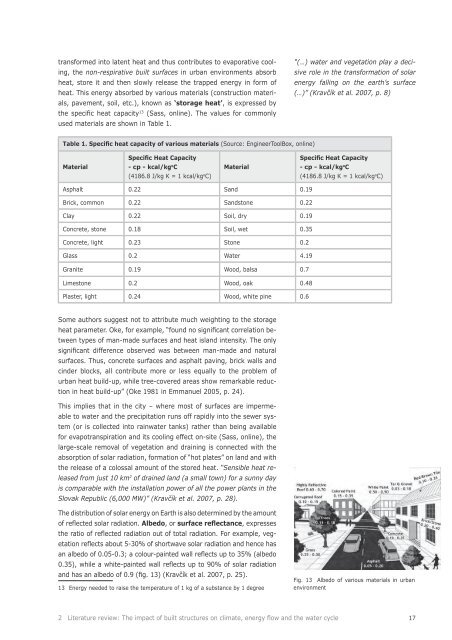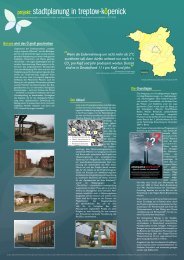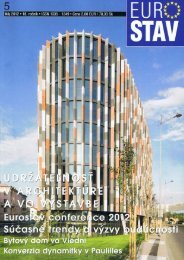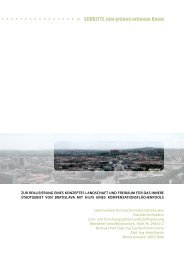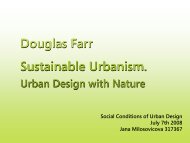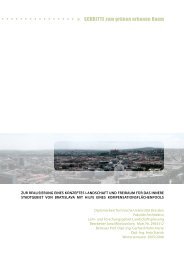transformed into latent heat and thus contributes to evaporative cooling,the non-respirative built surfaces in urban environments absorbheat, store it and then slowly release the trapped energy in form ofheat. This energy absorbed by various materials (construction materials,pavement, soil, etc.), known as ‘storage heat’, is expressed bythe specific heat capacity 13 (Sass, online). The values for commonlyused materials are shown in Table 1.“(…) water and vegetation play a decisiverole in the transformation of solarenergy falling on the earth’s surface(…)” (Kravčík et al. 2007, p. 8)Table 1. Specific heat capacity of various materials (Source: EngineerToolBox, online)MaterialSpecific Heat Capacity- cp - kcal/kg o C(4186.8 J/kg K = 1 kcal/kg o C)MaterialSpecific Heat Capacity- cp - kcal/kg o C(4186.8 J/kg K = 1 kcal/kg o C)Asphalt 0.22 Sand 0.19Brick, common 0.22 Sandstone 0.22Clay 0.22 Soil, dry 0.19Concrete, stone 0.18 Soil, wet 0.35Concrete, light 0.23 Stone 0.2Glass 0.2 Water 4.19Granite 0.19 Wood, balsa 0.7Limestone 0.2 Wood, oak 0.48Plaster, light 0.24 Wood, white pine 0.6Some authors suggest not to attribute much weighting to the storageheat parameter. Oke, for example, “found no significant correlation betweentypes of man-made surfaces and heat island intensity. The onlysignificant difference observed was between man-made and naturalsurfaces. Thus, concrete surfaces and asphalt paving, brick walls andcinder blocks, all contribute more or less equally to the problem ofurban heat build-up, while tree-covered areas show remarkable reductionin heat build-up” (Oke 1981 in Emmanuel 2005, p. 24).This implies that in the city – where most of surfaces are impermeableto water and the precipitation runs off rapidly into the sewer system(or is collected into rainwater tanks) rather than being availablefor evapotranspiration and its cooling effect on-site (Sass, online), thelarge-scale removal of vegetation and draining is connected with theabsorption of solar radiation, formation of “hot plates” on land and withthe release of a colossal amount of the stored heat. “Sensible heat releasedfrom just 10 km 2 of drained land (a small town) for a sunny dayis comparable with the installation power of all the power plants in theSlovak Republic (6,000 MW)” (Kravčík et al. 2007, p. 28).The distribution of solar energy on Earth is also determined by the amountof reflected solar radiation. Albedo, or surface reflectance, expressesthe ratio of reflected radiation out of total radiation. For example, vegetationreflects about 5-30% of shortwave solar radiation and hence hasan albedo of 0.05-0.3; a colour-painted wall reflects up to 35% (albedo0.35), while a white-painted wall reflects up to 90% of solar radiationand has an albedo of 0.9 (fig. 13) (Kravčík et al. 2007, p. 25).13 Energy needed to raise the temperature of 1 kg of a substance by 1 degreeFig. 13 Albedo of various materials in urbanenvironment2 Literature review: The impact of built structures on climate, energy flow and the water cycle17
Fig. 14 Photograph of the square and adjacentpark in Třeboň, Czech Republic, takenwith a thermal camera. The differences in temperaturesbetween the vegetation, façades androofs of the houses is visible. (Kravčík et al.2007, p. 33)Fig. 15 Aerial view of an industrial site in Berlin(Google)Fig. 16 Bioclimatic categorization of the samearea as a “burden” area (Environmental AtlasBerlin)As such, low albedo implies higher surface temperatures since largeramounts of energy are not reflected, but absorbed. This applies in caseof dark non-vegetated surfaces, in case of vegetated areas however,the cooling process of evapotranspiration takes place (Sass, online;Kravčík et al. 2007, p. 25). Vegetation has a darker colour and thus alower albedo than many other surfaces, e.g. white painted walls. Plantshowever, independently of reflectance, cool through evapotranspiration(fig. 14). This cooling effect of vegetation, evident from the infraredphotographs of the square and park in Třeboň (CZ), is much higher incomparison with the effect of reflectance. The temperature of the roofsand façades exceeds 30°C, whereas the temperature of the trees in thepark is around 17°C (Kravčík et al. 2007, p. 27-28). We can thus concludethat evapotranspiration is more effective than albedo.A hypothesis resulting from previous findings is, that even if albedoraising helps lower the air temperatures and the PET 14 by reflectingsolar radiation back into the atmosphere, this happens solely on local,microclimate level in the proximate distance to the particular surface;and it has no influence on the extent of the UHI and on the total heatamount in the atmosphere. This is because by reflecting, no transformationof incident solar radiation into the latent heat (the form of heatwith evaporative cooling effects) takes place. This can be confirmed inthe graphics, figure 15 showing a high-reflective surface of an industrialarea in Berlin; figure 16 showing the temperature “burden” impact ofthe same site. Thus, raising the surface reflectance should not be seenas “the only really effective way (…) to affect the radiation energy balance”as pointed out in Sass (online) and suggested by other authors(Gartland 2008). To truly affect the temperatures, building greeningmeasures should be preferred.The effectivity of the albedo parameter in densely built-up urban areasis arguable also due to another aspect: In an urban area, a great partof the reflected rays hits walls of adjacent buildings, and thus only asmall part of the solar radiation impinging on walls and streets is reflectedupward to the sky; most of the radiation being absorbed in thewalls of the buildings, regardless of the colour, to be stored as heat andreleased back into the atmosphere later (Givoni 1998, p. 269).For the above reasons, greening should have a higher priority indesigning of surfaces rather than creating light and reflectivesurfaces. Raising albedo values of non-vegetated surfaces should beseen as a surface adjustment measure of secondary importance, andshould be applied where no greening measures are possible (as e.g. incase of road infrastructure). Nonetheless, surface albedo is one offactors influencing local surface temperatures and should notbe omitted when deciding about the character of constructionmaterials, even when these are to be covered with vegetation. Dark,non-vegetated (low albedo) surfaces should be replaced bylight and reflective (high albedo) surfaces so that less sunlightis absorbed. For the purpose of glare avoidance, other light coloursmay be used instead of white.14 Physiological Equivalent Temperature, see glossary18Climate Sensitive <strong>Urban</strong> <strong>Design</strong> in Moderate Climate Zone: Responding to Future Heat Waves. Case Study Berlin Heidestrasse/Europacity


